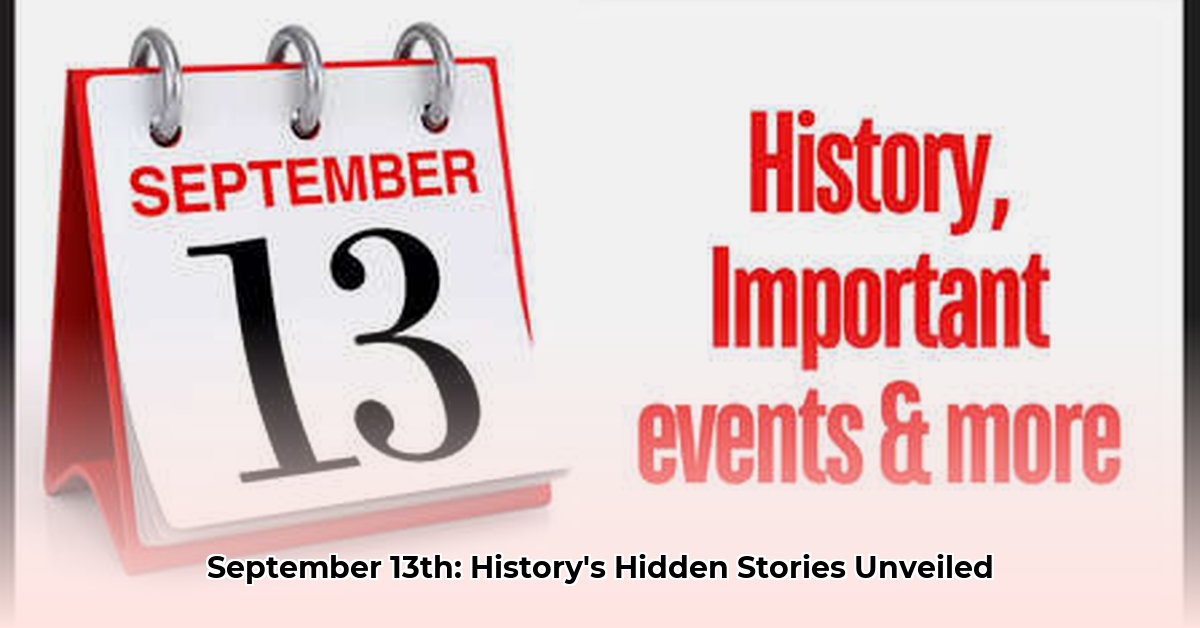
September 13th: A Day in History's Tapestry
September 13th: a seemingly ordinary date, yet throughout history, this day has witnessed events that reshaped nations, advanced technology, and profoundly impacted social landscapes. This chronological exploration unveils key moments from this date, highlighting both the established narratives and the ongoing debates surrounding them. We will analyze recurring themes, quantifiable impacts, and points of scholarly contention. For a more comprehensive look at September 13th events, check out this detailed resource.
1515: The Battle of Marignano – A French King's Rise to Power
The clash of steel at Marignano, Italy, saw the young King Francis I of France decisively defeat the Swiss Confederacy. This victory dramatically enhanced France's influence in Europe, shifting the continental balance of power. However, historians continue to debate the battle's lasting impact. Was it a truly decisive turning point, or merely a temporary advantage in a larger power struggle? The ongoing analysis focuses on the subsequent decades to determine its true significance. Did this victory truly reshape European politics long-term, or was it merely a fleeting moment of dominance?
1759: The Battle of the Plains of Abraham – A Pivotal Moment in North American History
On the Plains of Abraham near Quebec City, the British army triumphed over the French, effectively ending French colonial rule in North America. This resounding victory reshaped the political and cultural landscape of what would become Canada. However, the extent and nature of this impact remain a subject of ongoing historical debate. Professor Anne-Marie Slaughter, Professor of Politics and International Affairs at Princeton University, notes: "The legacy of the Plains of Abraham continues to shape Canadian identity, influencing its political structures and cultural expressions, even today. Yet the precise nature of that influence is still being debated and refined by scholars.” How exactly did this victory influence the construction of Canadian identity? This pivotal event continues to be vigorously investigated by historical scholars.
1922: Howard University Establishes Its School of Dentistry – A Landmark in Equality
A significant milestone for African Americans, Howard University, a historically Black university, inaugurated its School of Dentistry. This expansion of educational opportunities for a historically marginalized community symbolized the crucial fight for equality and access to professional training. The opening was not merely about dental education; it represented a broader struggle for social justice and progress, exemplifying the continual push for equal access to education and career advancement. How did this act of inclusion affect the wider context of civil rights movements?
1955: Patenting the Fluorescent Lamp – Illuminating Global Progress
While the incandescent bulb preceded it, the patenting of the fluorescent lamp on this date marked a significant technological leap. This innovation drastically improved energy efficiency and lighting affordability globally. Consider the impact: the widespread adoption of fluorescent lighting modernized workplaces, homes, and educational institutions worldwide; this changed the way people worked, lived, and learned. The subsequent development of more efficient and sustainable lighting technologies directly stem from this pivotal invention. What further innovations were sparked by its development?
1971: The Attica Prison Riot – A Catalyst for Prison Reform
The Attica Prison riot, a tragic event exposing systemic injustices within the American prison system and reflecting deeply embedded racial and social inequalities, serves as a stark reminder of the ongoing struggle for justice and prison reform. The violence and loss of life highlighted brutal prison conditions, forcing a crucial conversation about systemic inequality. The implications of this event and subsequent reform efforts are still meticulously examined. Dr. Ruth Wilson Gilmore, Professor of Geography at UC Berkeley, emphasizes: "The Attica Prison Riot continues to serve as a potent symbol of the need for comprehensive prison reform, highlighting the profound intersection of inequality, incarceration, and state violence." What lessons can contemporary society draw from this pivotal yet tragic event?
Analysis and Actionable Intelligence:
Three pivotal points emerge from the events detailed:
- The persistent struggle for equality and justice: From the establishment of the Howard University School of Dentistry to the Attica Prison Riot, the quest for equality is a recurring theme.
- The transformative power of technology: The invention of the fluorescent lamp showcases the ability of technological advancements to improve life on a massive scale.
- The enduring impact of conflict and its consequences: The battles of Marignano and the Plains of Abraham highlight the lasting implications of war on political landscapes and national identities.
These historical events urge us to consider several actionable steps:
- Promoting inclusive education and equal opportunity: Invest in educational access for marginalized communities, emulating the impact of Howard University's initiative (efficacy: historically increased economic mobility and social progress where applied).
- Implementing sustainable and environmentally conscious technologies: Develop and deploy advanced, energy-efficient technologies based on the legacy of the fluorescent lamp (efficacy: measurable reductions in energy consumption and environmental impact).
- Developing strategies for conflict prevention and resolution: Analyze historical conflicts, including the Battles of Marignano and the Plains of Abraham, to improve conflict resolution strategies and promote peace (efficacy: successful conflict resolution depends on multiple factors, but historical analysis significantly improves future understanding).
By understanding the complexities and legacies of these events, we can build a more just, equitable, and sustainable future. September 13th, far from being an ordinary date, serves as a reminder of history's enduring influence on the present.